In a recent post about the successful bid for the “Highway to Health” scheme, linking Leeds and Bradford by a cycling superhighway, Alison Pilling promised that some of the funding will go toward improving the “streetscape and the pedestrian environment”.
Streetscape I get (scape is a suffix “used to form nouns referring to a wide view of a place, often one represented in a picture” according to a good dictionary) but I do have a quibble with that pedestrian word.
I find it hard to think of other people as pedestrians.
If I’m bumbling around the city centre and happen upon a congregation of pink t-shirts and head boppers outside Yates’ Wine Bar I don’t think, hmm, why are all those pedestrians carrying a comedy inflatable penis. My normal reaction is, Geordie girls down for a hen do … And I turn in the opposite direction and walk away as fast as my legs can carry me..
I can’t remember ever once even considering myself a pedestrian.
Walking has been my favoured method of transport ever since I first learned to remain vertical without the assistance of domestic furniture. Which was a hell of a long time ago. As a very lazy 15 month old, I hauled myself up the side of the radiogram – clutching at the AM dial and accidentally switching over to Radio Bucharest – and made a play for the tennis ball that my uncle Jim’s Boxer dog Rover had recently finished masticating, and by some miracle managed to stay on my feet. At least until my face came in contact with Rover’s slavering jowls. The art of changing direction is something I never managed to master entirely. I’m still practically toddling to this day, Somehow I doubt all those years ago my mother turned proudly to my dad and said, “Aww, that’s so cute, our Philip’s finally become a proto-pedestrian.”
I’ve never consciously traversed a “pedestrianised” part of town feeling thankful for this anomalous enclave of calm and civility either.
Cities have been around a lot longer than motorized transport, and I’m sure that cities are all the better for keeping the intrusion of petrol powered vehicles to a minimum. We don’t call streets ruled by cars and lorries and taxis “motorized” so I don’t see why we should give in to the notion that this is the normal state of affairs and the “pedestrian” constitutes a special problem that requires an “environment” specifically designed to reduce their annoyance to the car driver.
Pedestrian has always been a loaded concept. The word was always defined against a superior mode of transport. In Latin the word pedester originated quite a while after equester to define those people not wealthy, important or civilised enough to own some serious horse power. And, as the Oxford English Dictionary notes, the Greek word meant “prosaic, plain, commonplace, uninspired (sometimes contrasted with the winged flight of Pegasus).” Legs alone couldn’t compete with a supersonic steed.
Not to gad about on a horse – or the modern equivalent – is to be inferior. Lacking. Definitely second class. There are several thousand years of transport based condescension and dismissiveness wrapped up in that word, pedestrian.
Same goes for that loathsome phrase, “pedestrian environment”. Pedestrians are a bit like the meek in the New Testament (Matthew 5.5). They might inherit the streets … but only once the car drivers have carved them up.
I decided to take Alison at her word when she said that she thought “pedestrian environment” was simply “what it feels like when you are ambling around”. So I ambled around a bit yesterday with a camera, and here’s what it felt like.
First thing you notice if you are navigating the city on foot is that you have to watch where you are walking. The pavements can be full of what my health and safety conscious chums call “trip factors”.
Most of the cracked and damaged paving stones are next to the road – suggesting that they were broken by excess vehicle weight and making crossing the road slightly more risky (you don’t want to trip into the path of a delivery truck.)
The other invisible threat is that many of these stones have worked loose and wobble. When it rains a reservoir forms beneath the stone, becoming a nasty sort of practical joke for the unwary walker. Many a time I have arrived at work squelching a shoeful of fetid water after treading on one of these loose stones.
Of course that’s not all you fear treading in. Some people treat the public footpath as their personal ash tray, spittoon and dog toilet. I didn’t think a picture of any of that would be nice though.
Wandering around the non-pedestrianised streets it is immediately and blindingly obvious that you are here on sufferance. If there are road repairs the signs warning drivers are plonked on the pavement (and there’s generally an apology – for inconveniencing the motorist.) But, don’t worry, we’ll squeeze past.
What’s also apparent is that 90% of the signage in the street (or, to be more precise, obstructing the pavement) is absolutely irrelevant to walkers. The signs are ridiculously large, not built to human scale, and made from materials and colours meant to be seen at speed and from a distance. You can stand on almost any street in the centre of Leeds and know which lane you need to be in to drive to York or Selby, where there’s a no left turn coming up and when the road repairs will be finished, but you could be forgiven for not knowing the way to the shops or where the nearest public toilet was if you were just visiting. (To be fair the new city maps are really good, but still a minority of people don’t see them.)
Once you manage to escape into a non-motorized street things are very different. The first thing you notice is there’s no lanes – people manage to walk just about any direction at whatever pace is comfortable and nobody gets hot and bothered. And there’s no “segregation” – bikes and scooters and skateboards share the same space without much problem (possibly because the pace of movement is regulated by walking speeds?) And there’s a total absence of sign clutter (although some might say they’d rather have a screaming yellow traffic information sign in the middle of Briggate than the public art that’s been foisted on us – which is, as my granddad would say, neither use nor ornament.)
And you can hear yourself speak. And this guy play … he’s rather good.
There’s room for visual delight too. I love the way the hanging basket obscures the (very small) traffic sign.
They are everywhere.
Perhaps a bit excessive now? There’s a bus hidden behind this flowery barricade … I’m all for minimizing the impact of traffic but I’d also like to make it across the Headrow without mishap.
Have to love how monstrous these things are though, bigger than an average human male.
Leeds is great for trees (and the shade they provide) and litter bins (and if we could only get our gum chewing, fag smoking, dog walking friends to learn how to use them I’d be most happy.)
Interestingly that silver pillar thing (anyone know what they are called?) has obviously been the victim of a reversing vehicle collision, as have most of the bicycle posts along the top of Lands Lane. Even “pedestrianised” areas aren’t safe from damage.
It’s hard to tell from this picture but there were far more people walking and sitting in cafes on the shady side of the street than the sunny. I wonder why?
More street entertainment. You don’t get this where the cars drown you out.
These old ladies were chatting and laughing about a bunch of young lads who had just passed on skateboards (one had a bike with no seat, which was the cause of considerable merriment). One of the lads attempted a manoeuvre that simply defied the laws of human physiognomy and ended up cracking a knee against the wall behind. The older lady fished an elastoplast from her bag …
Lovely how people find their own pace and rhythm.
And they’ll even use the dreadful seating on offer (on the 2 or 3 days of the year that solid marble won’t be too wet or buttock-numbingly freezing.)
Human scale buildings, plenty of room, no clutter, and look … people are stopping to talk to each other in the public street … in Leeds!
These traffic signs I can forgive.
Guy texting in the shade of a tree, young girl enjoying the sunshine, and nobody rushing anywhere much.
One thing I think Trinity shopping centre has improved dramatically is the walkability of Lands Lane – used to be pitiable down here. Mr Brown, Mr Pink and Mr White obviously agree.
I don’t like these tramlines. Look at how they seem to unconsciously regulate the direction of walking in such a rigid way compared to unmarked streets.
At last, some useful signs …
If you want to know where the International Pool was …
Fortunately nobody will notice as the tree is in the way.
Anyway, that was a half an hour amble taking in the “pedestrian environment” of Leeds one late morning this week. I’m sure I missed loads. And maybe I shouldn’t be so harsh on the “P” word.
I wonder what Alison thinks?
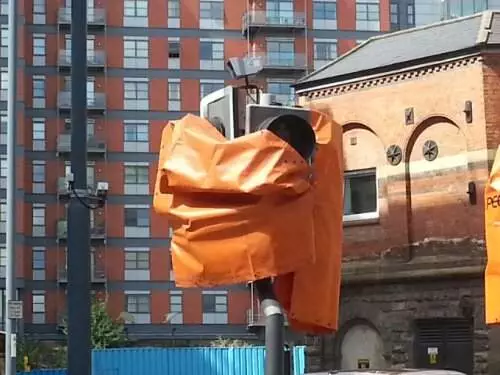
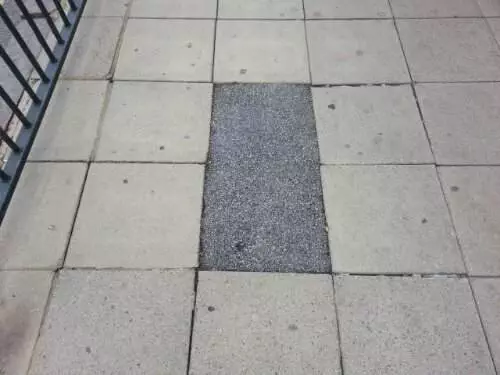
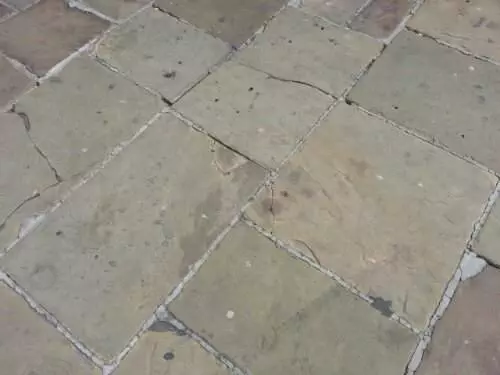
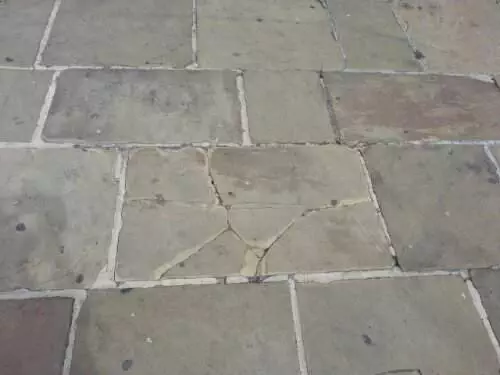
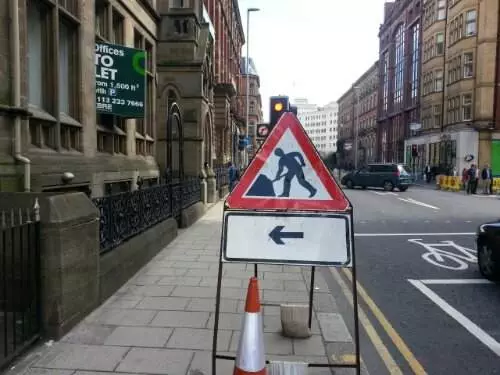
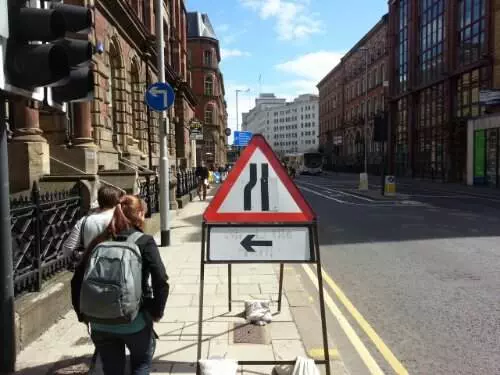
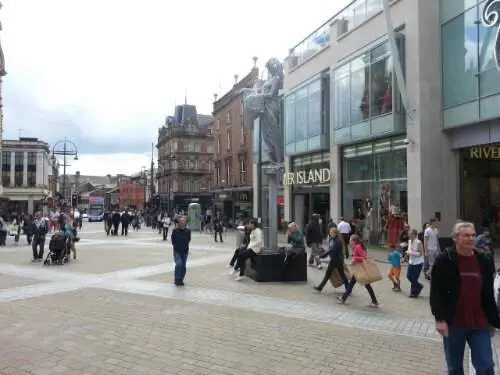
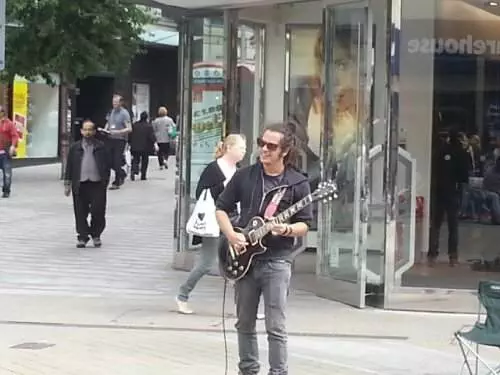
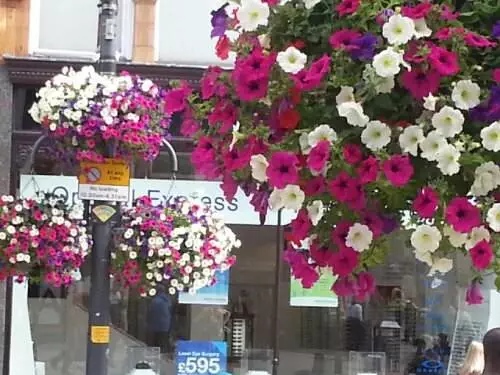
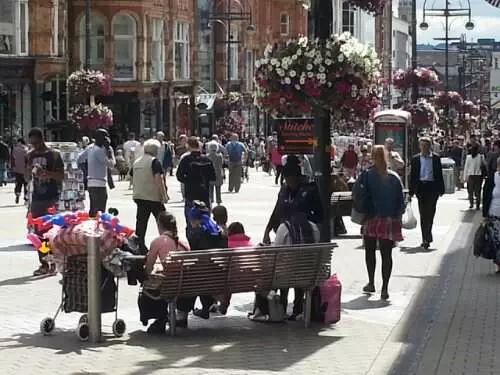
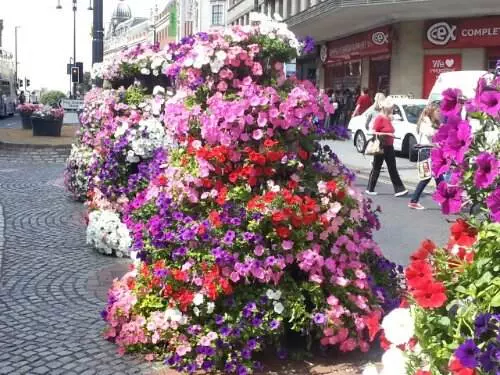
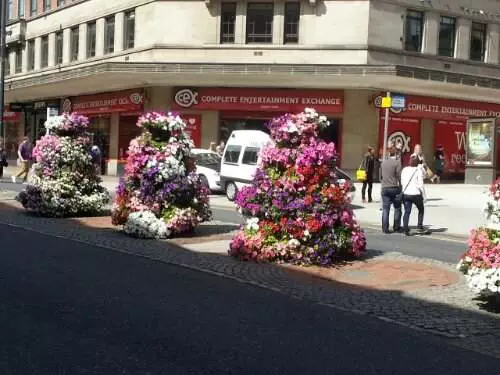
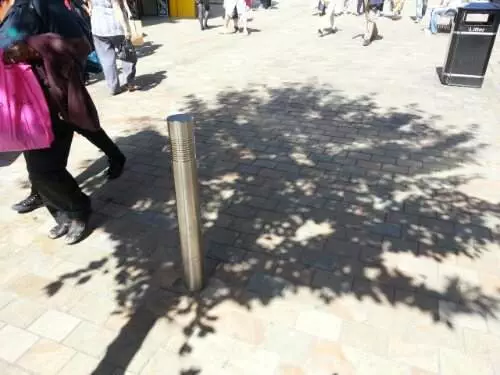
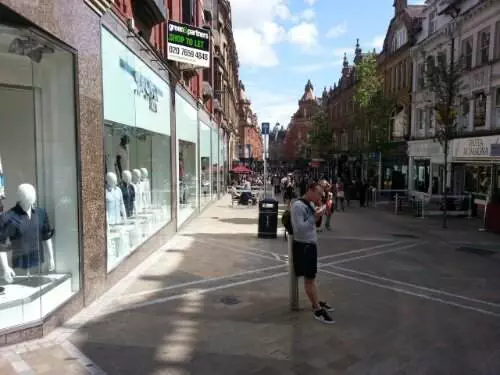
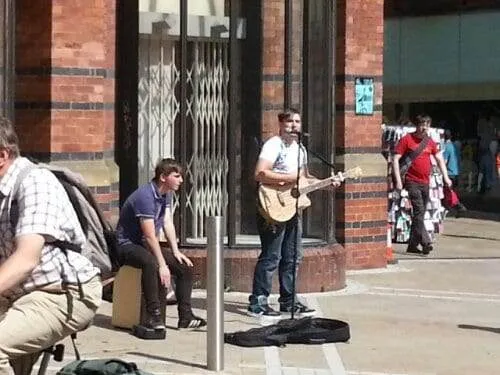
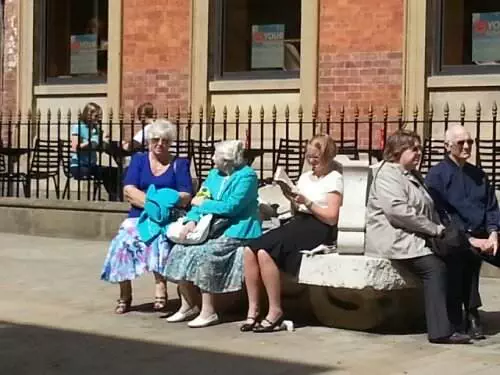
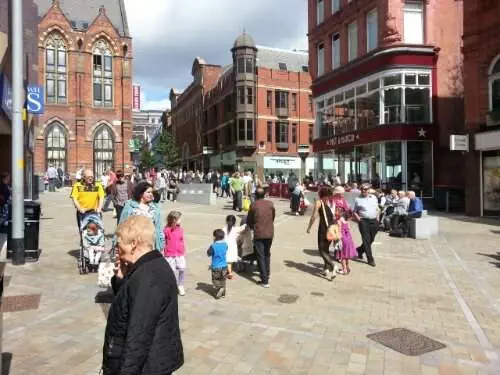
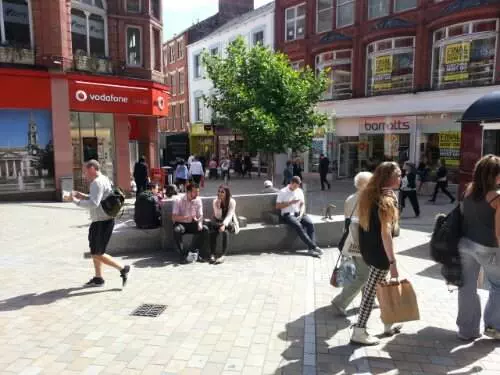
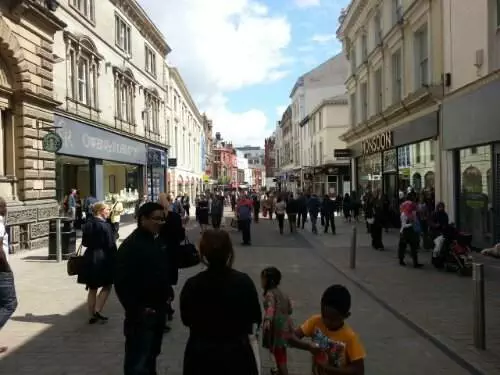
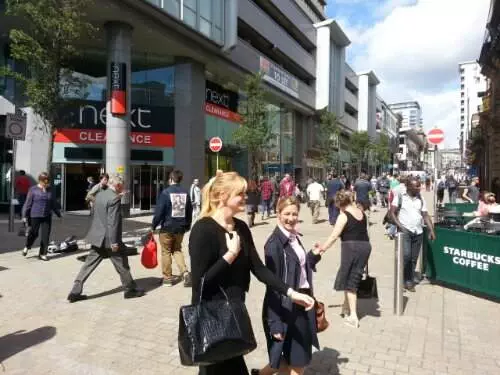
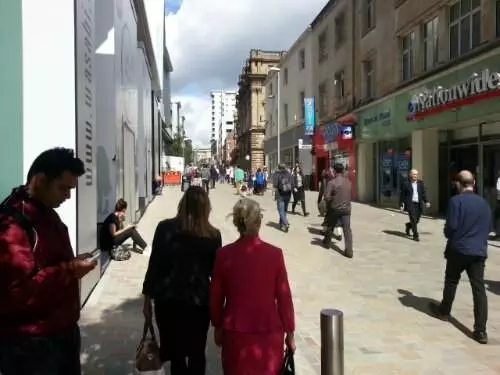
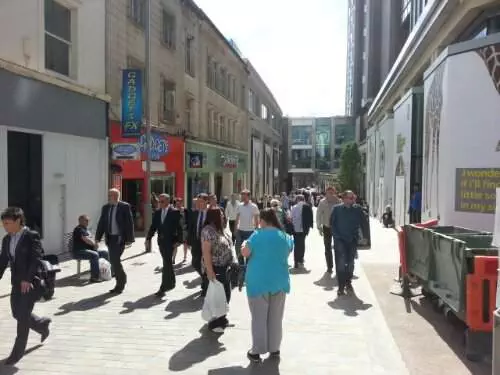
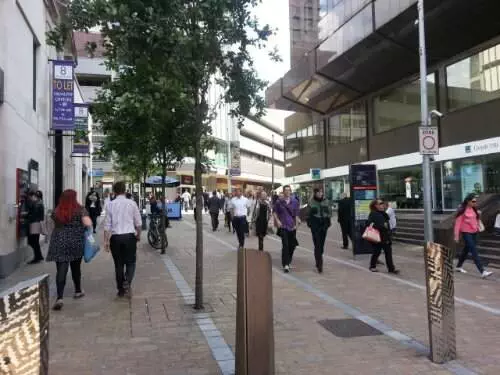
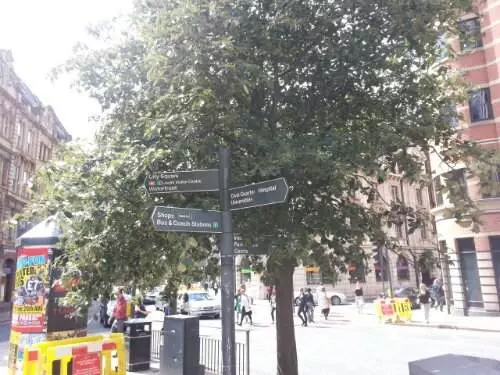
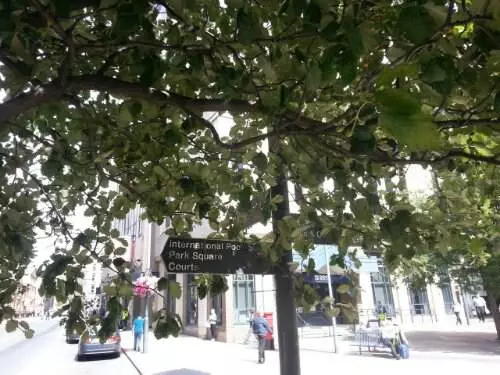
Aah, well you see I did Latin for one year only, during which time I learnt that some lad called Marcus was playing in the garden (in horto laeterat) and that Roman soldiers were doing something about an aqueduct. We never got onto the implicit undermining of the common walker.
Two things though:
I think your photos make the point that some places are nice to walk around and to just be in, some are not. I don’t view the first as pedestrianised and the second as motorised. They are all part of the pedestrian environment in the sense that people are walking around in them but the latter aren’t that nice.
Hence my comment that we need to improve the pedestrian environment, not necessarily the bits round Lands Lane and that but the bits round Wellington Street where pavements aren’t mended and people leave roadworks signs where we have a right to walk without obstruction.
The relevance to the Highway to Health post is that there is a risk that in improving facilities for cyclists, we forget the impact on people walking around. I am very keen that we improve the experience for both.
Integrating people & cars is a problem everywhere, the 2 just don’t mix well, throw in cyclist who flit between road & pavement and you have disgruntled people form all sides.
The best thing to happen in urban design for years is the High Line in New York. I heard, once upon a time Leeds was meant to have high level pedestrian routes, but alas this never happened. I say bring it back, up put cars under street level.
I saw recently (although can’t remember details) that a European city had sunk a stretch of its inner ring road underground and created a large city park above it, making the environment for the people using buildings around vastly improved.
Oh and that silver pillar thing is classed as “street furniture” and is just a bollard I’m guessing to keep any delivery vehicles (or ram raiders) away from the shop fronts.
Bollards! Of course … and most of them seem to be wonky.
There’s a video somewhere of the proposed Leeds High Line (was the viaduct). It did look lovely but I’m not sure it would have been terribly practical. I mean, who’d want to walk to Armley?
I didn’t mean the Leeds “high line” to Armley. In the 70’s there were proposals for a “Skyway” across the city. A few bits got built, can’t find any dacent pics but this was at city square, http://www.flickr.com/photos/cliffordstead/7397093346/
I guess, poor design and that the roads were not as busy then as they are now meant it didn’t get used much and so never fulfilled its potential and got scrapped & demolished.
photo of Leeds back in the day. You can make out the bit of Skyway that was built going around the top of City Square & along Infirmary Street.
http://www.flickr.com/photos/danielrobot/2326259357/sizes/l/in/set-72057594048827351/
You’re right! I’m going to start saying “de-motorization” now.
This is a subject I feel strongly enough about to have done some research about how it’s handled elsewhere.
The city of Louvain-la-Neuve in Belgium was constructed after cars became popular (its history is bizarre and fascinating). They decided walkers would be first-class citizens so drivers are relegated to underground roads and car parks. I’d love to visit to see the impact (Google Street View is quite dull, because the images were all taken from cars!)
Another interesting place is the under-construction Masdar City in Abu Dhabi. Cars are completely banned within the city walls, and instead the whole city is linked by personal on-demand trams like the ones at Heathrow Terminal 5.
Here you go, the Holbeck Viaduct… http://www.baumanlyons.co.uk/projects/connecting-edges/holbeck-viaduct
I refute your suggestion that Leeds has lots of trees. It has some but nowhere near enough. European cities seem to be well populated with trees and they make a huge difference in ‘softening’ the hard edges of buildings.
To make it more pleasant for pedestrians (and motorists) plant more trees in city centres.